Physical Address
304 North Cardinal St.
Dorchester Center, MA 02124
Physical Address
304 North Cardinal St.
Dorchester Center, MA 02124
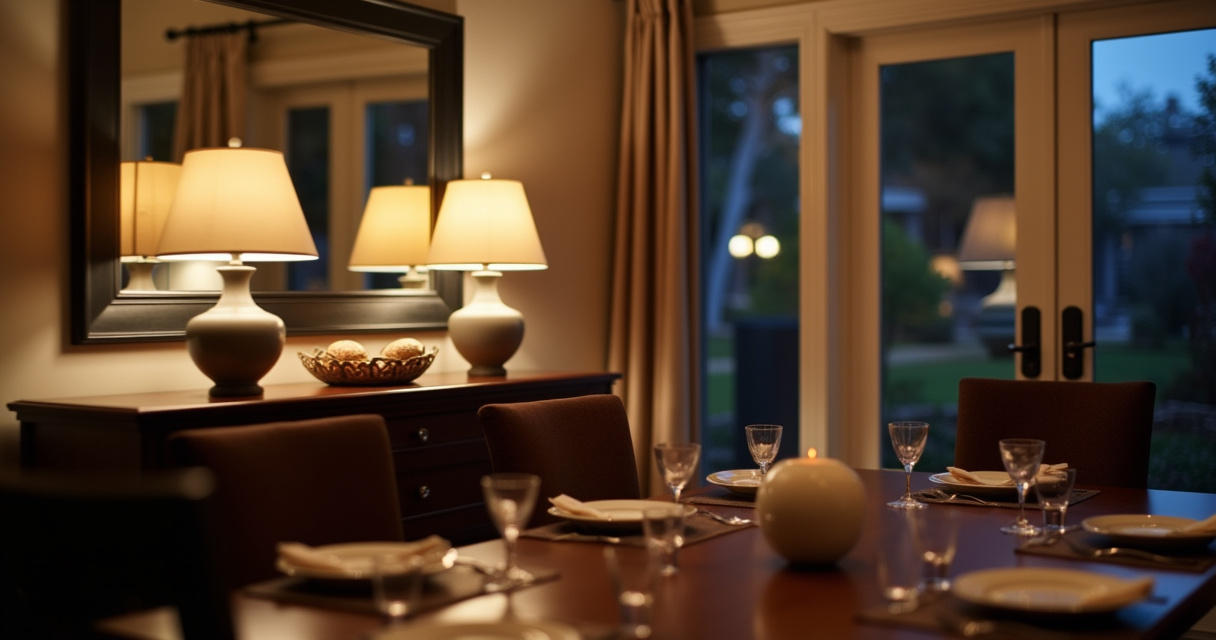
Is your dining room feeling a little… lackluster?
While we often focus on furniture and decor, the right lighting can truly transform a space from ordinary to extraordinary. As a designer who blends traditional elements with modern aesthetics, I’ve witnessed how a thoughtfully chosen dining room light can elevate not just the visual appeal of your space, but also the entire dining experience.
Light shapes our perception, influences our mood, and brings warmth to our gatherings. In Islamic design, light has always been revered as a symbol of divine presence—a reminder that beauty reveals itself through illumination. This philosophy translates beautifully into contemporary dining spaces, where the right lighting creates ambiance for everything from festive celebrations to intimate conversations.
Let me guide you through 18 stunning dining room lighting options that will transform your space and enhance every meal shared around your table.
When you want to make a truly unforgettable impression, nothing quite rivals the grandeur of a statement chandelier. These aren’t just light fixtures; they’re architectural focal points that command attention and infuse your dining room with an unparalleled sense of elegance.
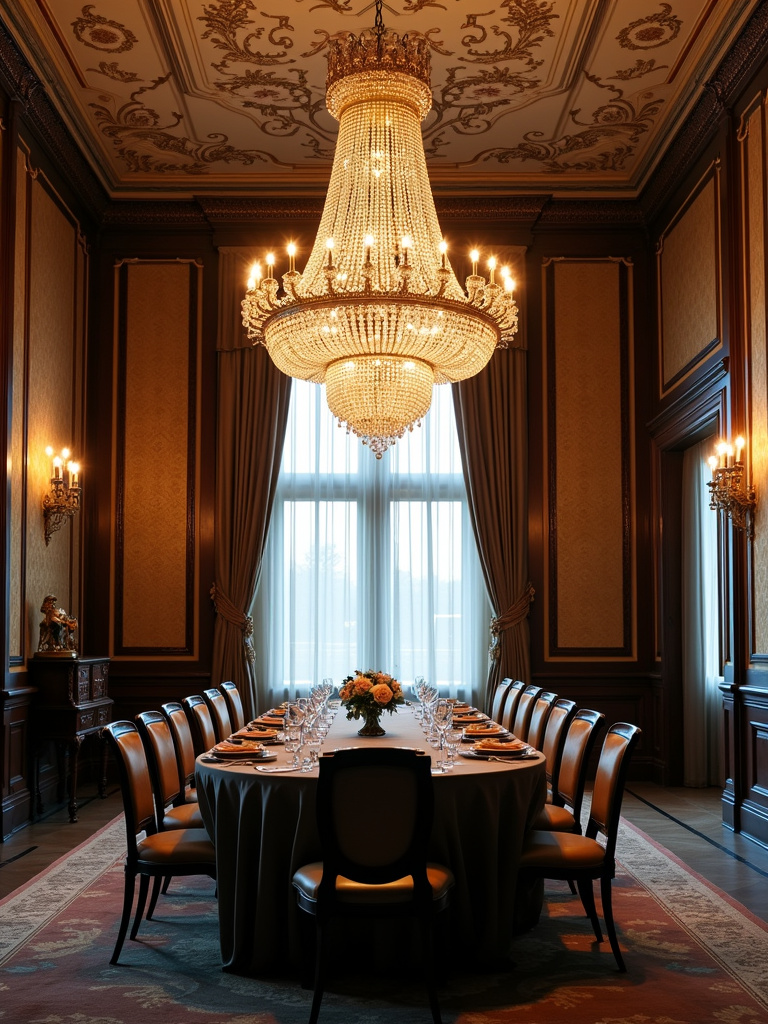
Imagine your guests entering and their gaze immediately drawn upward to a dazzling display of light and design. Statement chandeliers create a sense of occasion, adding a touch of luxury that transforms even everyday meals into special events. For optimal impact, ensure your ceilings are at least 8 feet high—ideally 9-10 feet or more—so the chandelier has room to breathe and doesn’t overwhelm the space.
“The right chandelier doesn’t just illuminate a room—it elevates the entire experience of gathering around the table.”
For formal dining rooms, consider a chandelier with cascading crystals that will maximize drama through light reflection. When selecting the proper size, here’s a designer trick: measure your dining table’s length and width in feet, add those numbers together, and that sum in inches gives you the ideal diameter for your chandelier.
Quick Tips:
Here’s where it gets interesting… while grand chandeliers are traditionally associated with formal spaces, they can also work beautifully in transitional settings when paired with more modern furniture for an eclectic, curated look.
For dining rooms that embrace clean lines, uncluttered spaces, and a distinctly modern aesthetic, sleek pendant lights offer the perfect blend of form and function. Unlike their more ornate counterparts, modern pendants provide focused illumination while contributing to the overall contemporary vibe with their minimalist design language.
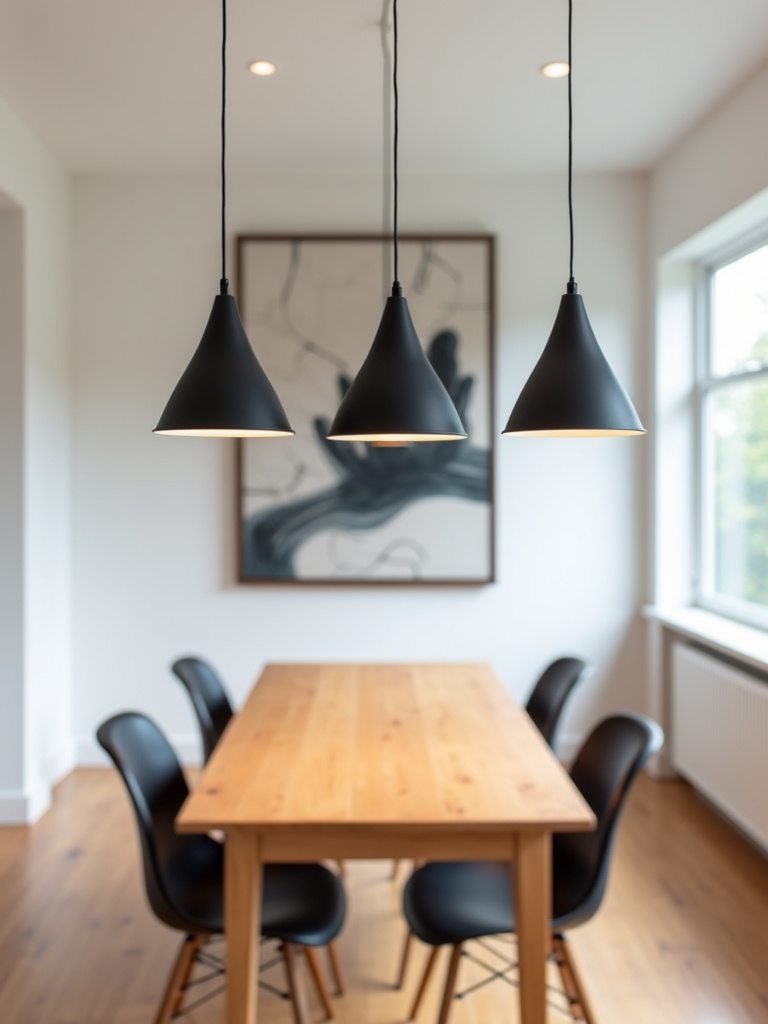
Popular materials for these fixtures include brushed nickel, matte black, polished chrome, and blown or frosted glass. The beauty of modern pendant lights lies in their adaptability—they can be used individually as striking focal points or arranged in multiples for greater visual impact and more even lighting across your dining surface.
For a clean, linear look that enhances a modern rectangular table, try a row of three identical minimalist pendant lights in matte black. This creates a rhythmic element that draws the eye across the dining area while maintaining a sense of visual harmony. For round tables, a single larger pendant or a cluster of smaller ones creates a balanced composition.
But what about practical considerations? When hanging pendant lights, aim for approximately 28-32 inches between the bottom of the pendant and the dining table surface. This height provides optimal illumination without blocking sightlines across the table. And always consider installing dimmer switches—especially with brighter LED bulbs—to easily transition from bright task lighting during meals to softer mood lighting for after-dinner conversations.
The surprising part is… these seemingly simple fixtures often have their roots in utilitarian designs. The industrial design movement heavily influenced modern pendant styles, leading to the popularity of exposed bulbs, metal cages, and clean, functional forms that now grace the most sophisticated contemporary dining spaces.
Not every dining room boasts soaring ceilings or expansive dimensions. For cozier spaces with lower ceilings, flush mount lights offer an elegant solution that doesn’t sacrifice style for practicality. These fixtures sit directly against the ceiling, maximizing vertical space while providing essential illumination that envelops the entire room.

Many homeowners wonder if flush mount lights can provide sufficient brightness for dining areas. The answer is a resounding yes—when selected with appropriate wattage or lumen output, these fixtures deliver ample general lighting. What’s more, they’re available in a surprisingly diverse range of styles, from minimalist and modern to decorative designs with patterned glass shades or interesting metal details.
In a small dining nook, a stylish flush mount can serve as the sole light source, keeping the space feeling open and uncluttered while still making a design statement. For added interest, look for fixtures with:
What many people overlook… is that flush mount lights (affectionately known as “ceiling huggers”) are among the most energy-efficient types of ceiling lighting, especially when using LED bulbs. They maximize light output in a compact form, directing illumination throughout the space rather than focusing it in one area.
When installing a flush mount light, ensure the junction box in your ceiling is properly rated to support the fixture’s weight. And if you desire more directional light, consider semi-flush mounts, which hang down slightly more than flush mounts and can sometimes offer better light distribution.
If you crave adaptability and precise control over your dining room illumination, track lighting might be your perfect match. Unlike fixed fixtures that provide light from a single point, track lighting offers exceptional flexibility, allowing you to direct light exactly where you need it—be it highlighting artwork, emphasizing your table setting, or washing an architectural feature with warm illumination.
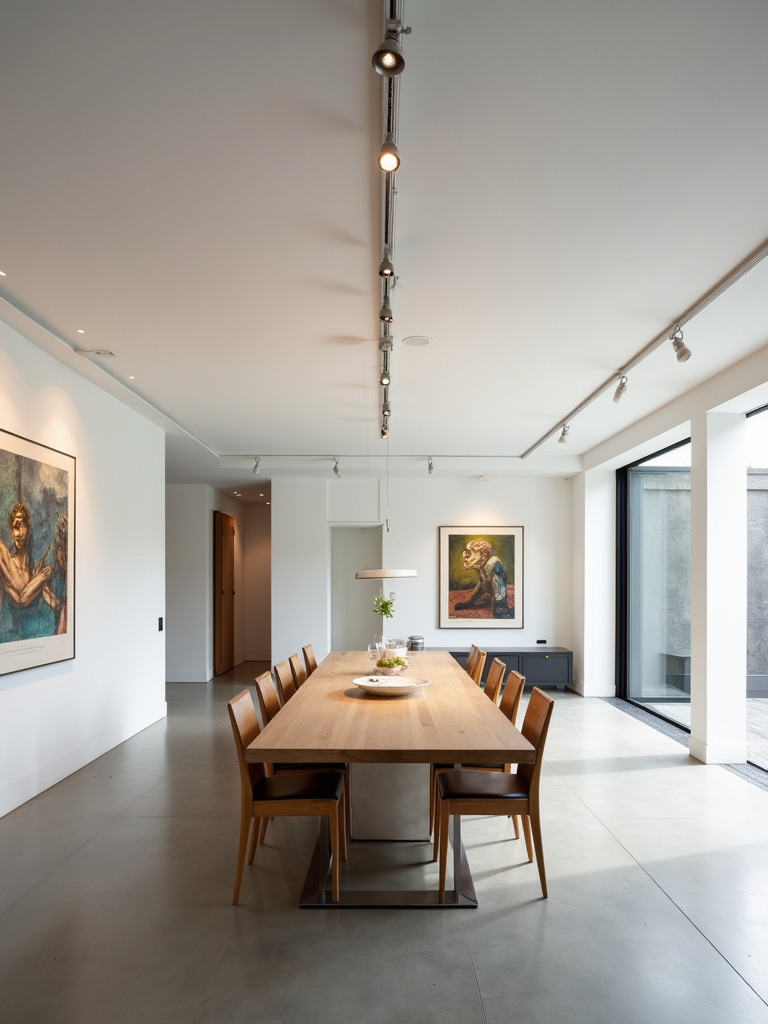
This is where everything changes… track lighting isn’t limited to modern or industrial styles as many assume. Choose track heads in elegant finishes like brass or oil-rubbed bronze and aim them strategically to elevate even formal dining spaces. The system’s versatility means you can adjust the position and direction of individual light heads, add or remove lights as needed, and completely transform your lighting scheme without major renovations.
For a distinctive approach, consider using track lighting to create a gallery-like experience in your dining room. Combine ambient downlights over the table with accent lights directed at artwork or collectibles displayed on walls. Or install curved track lighting to follow the architectural lines of your dining room, creating a more organic lighting arrangement that feels intentional and custom-designed.
Designer Insight:
“Track lighting originated in commercial and retail settings for showcasing merchandise. Today’s residential systems combine that functional versatility with refined aesthetics suitable for even the most elegant dining spaces.”
Before installation, plan your track lighting layout carefully. Consider the areas you want to illuminate and the direction of the light heads. Sketch it out on paper or use a room planning tool to visualize the effect. And always ensure the track is securely mounted to ceiling joists or studs, especially if using heavier track heads.
The key detail though… modern track lighting systems come in various voltages and can accommodate different types of bulbs, including energy-efficient LEDs and smart bulbs that can be controlled via apps or voice commands, bringing cutting-edge technology to this adaptable lighting solution.
Wall sconces are the unsung heroes of dining room lighting, working quietly to create layers of warmth and depth that overhead fixtures alone simply can’t achieve. These wall-mounted lights add dimension to your dining space, softening the overall illumination while contributing to a more intimate and inviting atmosphere.
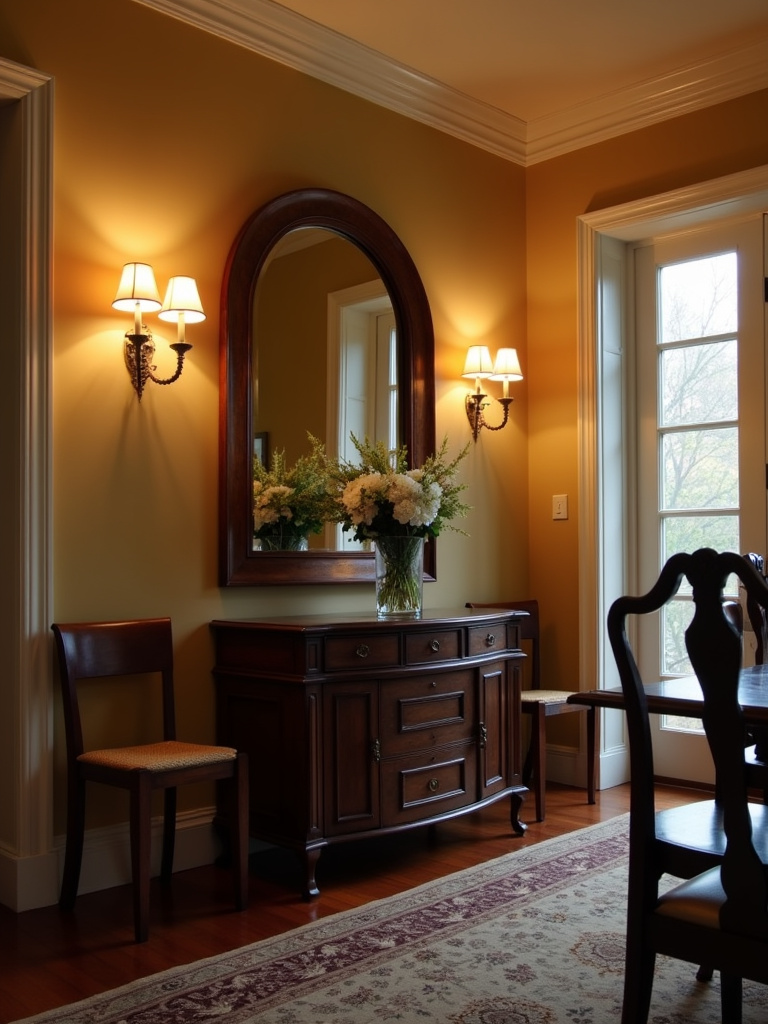
Typically mounted at eye level—about 60-66 inches from the floor to the center of the sconce—these fixtures provide soft, indirect lighting that washes walls with gentle radiance. This creates a cozy ambiance perfect for lingering conversations over dessert and coffee. In Islamic design tradition, this indirect lighting mimics the diffused glow through intricate mashrabiya screens, creating patterns of light and shadow that add subtle complexity to the room.
Let me explain… wall sconces work best when used alongside other light sources as part of a layered lighting scheme. Try using dimmable sconces in conjunction with a central pendant or chandelier to create multiple lighting scenarios suitable for different occasions—from bright, energetic family gatherings to romantic dinners for two.
For maximum impact, install sconces with both upward and downward light to create a dramatic play of light and shadow on your walls and ceiling. Space them evenly, considering furniture placement and artwork. A common spacing is 6-8 feet apart, but adjust based on your room’s dimensions and the size of the sconces themselves.
Historical Note: Wall sconces have a rich heritage, having been used for centuries to hold candles and oil lamps before electricity. Today’s versions honor this legacy while incorporating modern technology and design sensibilities.
The crucial point is… sconces add personality to a dining room without consuming valuable floor or table space, making them ideal for smaller rooms or spaces with limited surface area. When wiring wall sconces, ensure they connect to a wall switch for easy control, and consider using a dimmer for adjustable ambiance that can transform with the occasion.
While often overlooked in dining spaces, elegant table lamps bring a level of intimacy and warmth that overhead lighting simply cannot match. Placed strategically on sideboards, buffets, or console tables, these versatile fixtures add a soft glow at eye level that complements your primary dining room light and creates a layered, sophisticated lighting scheme.
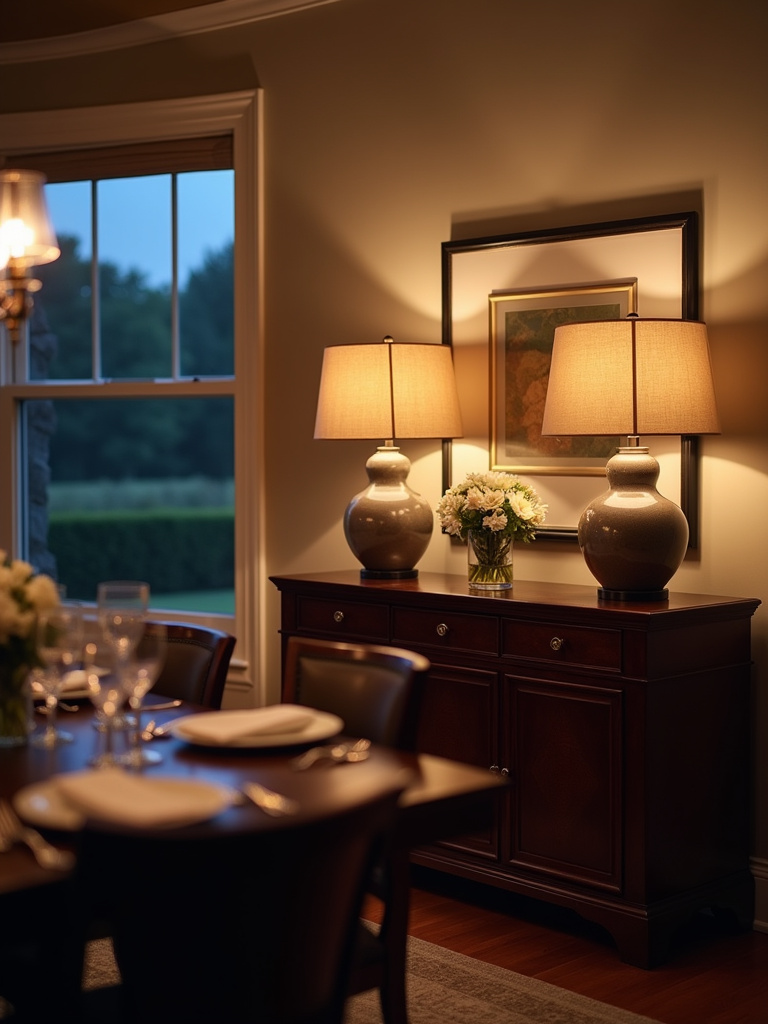
Picture it this way… when overhead lights illuminate your dining table, table lamps fill in the surrounding space with gentle, ambient light that frames the room and creates a more balanced visual experience. The warm pools of light they create at the room’s perimeter draw the eye around the space, making even modest dining rooms feel more expansive and thoughtfully designed.
For maximum impact, use a pair of matching lamps on a sideboard to create symmetry and flanking light that frames your dining area. Choose lampshades in natural materials like linen or cotton in neutral colors—ivory, beige, or soft gray—as these diffuse light softly and create that coveted warm, inviting glow. Avoid overly dark or opaque shades that block too much light and diminish the lamp’s effectiveness.
Practical Considerations:
Table lamps are among the oldest forms of portable lighting, evolving from oil lamps and candles to the electric versions we use today. This historical lineage makes them particularly appropriate in dining spaces, where traditions of gathering and breaking bread together stretch back through human history.
It all boils down to this: the right table lamps don’t just illuminate your dining room—they create atmosphere, add a decorative element, and contribute to the overall sense of hospitality that makes a dining space truly special. Their gentle glow invites guests to linger, creating the perfect backdrop for meaningful conversations and memorable meals.
In a world often cluttered with excess, minimalist dining room lights offer a refreshing counterpoint with their clean lines and understated elegance. These fixtures embrace the “less is more” philosophy, focusing on essential forms and rejecting unnecessary embellishment to create a sense of calm and intentionality in your dining space.
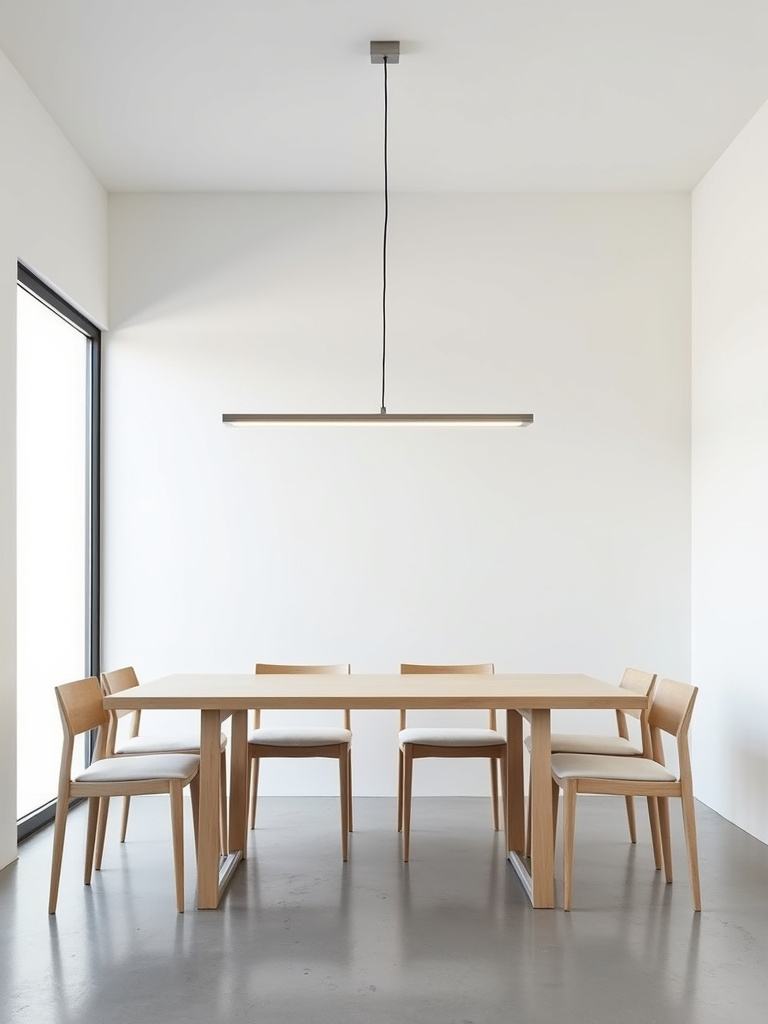
The key characteristics of minimalist dining room lighting include clean geometric shapes, neutral colors (typically black, white, gray, or brushed metal), and an emphasis on function over decoration. The simplicity of these fixtures allows other design elements to shine while still providing excellent illumination exactly where you need it.
This approach aligns beautifully with aspects of Islamic design philosophy, where geometric clarity and purposeful restraint create spaces of serene beauty. In minimalist lighting, as in traditional geometric patterns, there’s an underlying mathematical harmony that brings order and tranquility to the environment.
Here’s what’s fascinating… despite their apparent simplicity, minimalist fixtures require careful consideration of materials and proportion. LED bulbs are particularly well-suited to these designs, offering energy efficiency, long lifespans, and clean, bright light that enhances the contemporary aesthetic. For a touch of warmth within the minimalist framework, Edison bulbs can add vintage appeal while maintaining the overall simplicity.
Consider these approaches for minimalist dining room lighting:
When choosing minimalist lighting, focus on quality materials and construction over elaborate details. Simple, well-made fixtures with clean lines will stand the test of time both structurally and aesthetically. Keep your color palette consistent with the overall dining room décor, sticking to a limited range of neutral tones for a cohesive look.
The breakthrough came when designers began to recognize that simplicity doesn’t mean boring—it means allowing each element to fulfill its purpose with clarity and intention. Minimalist lighting exemplifies this principle, creating dining spaces that feel clean, calm, and thoughtfully curated.
For dining rooms that exude classic elegance and enduring style, traditional chandeliers remain an undisputed choice. Unlike their contemporary counterparts, these fixtures embrace ornate details and historical references, creating a sense of timelessness that elevates any formal dining experience.

The defining features of traditional dining room chandeliers include scrolled arms, candle-style bulbs, crystal accents (though not always), and finishes like polished brass, oil-rubbed bronze, or antique gold. These elements come together to create a formal, elegant look that brings a sense of occasion to your dining space.
Let me walk you through it… traditional chandeliers thrive in dining rooms with formal furniture sets, especially those crafted from rich woods like mahogany or cherry. They complement upholstered chairs with classic lines and rooms adorned with rich colors and traditional décor elements like damask wallpaper or Persian rugs. For a truly grand dining room, choose a tiered traditional chandelier with multiple arms and candle bulbs.
Historical Context:
“Traditional chandelier designs draw inspiration from various historical periods, including Victorian, Georgian, and French Empire styles. Each brings its own distinctive details and proportions that have stood the test of time.”
Many traditional chandeliers are designed to accommodate candelabra bulbs, mimicking the look of real candles and enhancing the classic aesthetic. This historical reference creates a connection to dining traditions that stretch back centuries, adding depth and meaning to your lighting choice.
When selecting a traditional chandelier, scale is crucial. A fixture that’s too small will look underwhelming in a formal dining room, while an oversized one can dominate the space uncomfortably. Aim for balance and proportion that complements your table size and ceiling height. And don’t forget maintenance—dust traditional chandeliers regularly, especially those with crystal elements, to maintain their sparkle and prevent dust buildup in intricate details.
But what if you want the elegance of a traditional chandelier without committing to a fully traditional dining room? Consider a transitional fixture that bridges classic and contemporary styles, offering traditional shapes with cleaner lines and updated finishes. This approach gives you the best of both worlds—timeless elegance with a fresh, current sensibility.
If you yearn for a dining room that feels warm, inviting, and infused with country charm, rustic farmhouse pendant lights offer the perfect solution. These fixtures celebrate natural materials and unpretentious designs, creating a welcoming atmosphere that instantly makes guests feel at home.
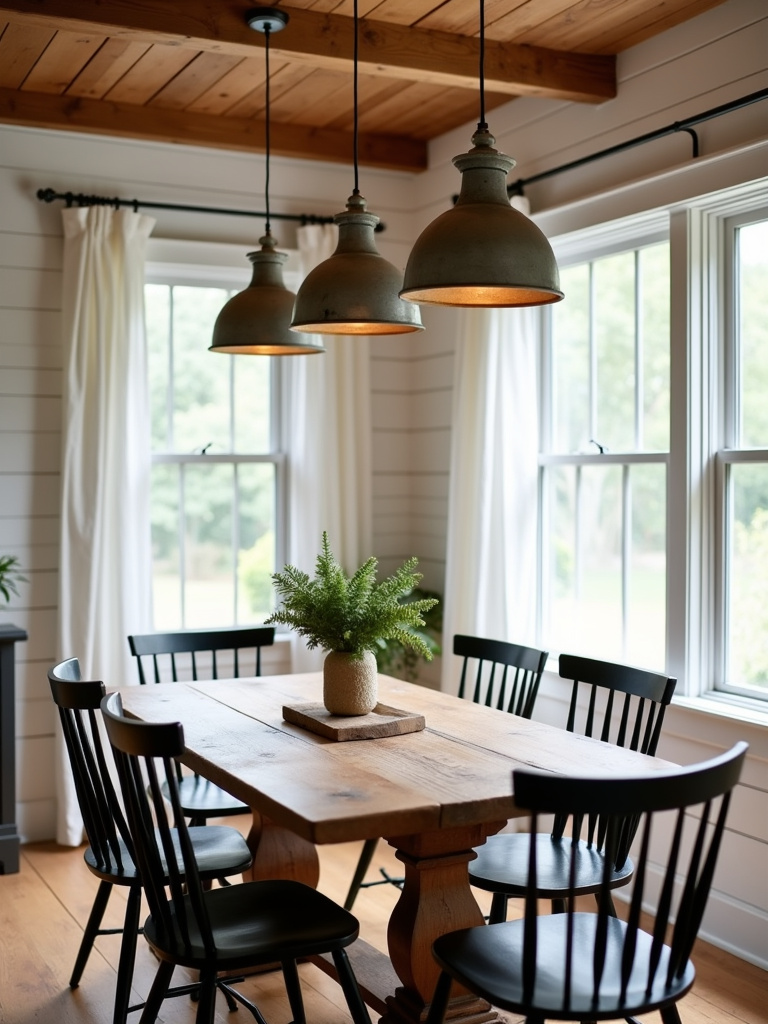
But here’s the thing – farmhouse lighting is about more than just aesthetics. It connects us to traditions of hospitality and simplicity that resonate across cultures. The materials commonly used in these pendants – wood, iron, galvanized metal, mason jars, and rope accents – bring textural interest and a sense of authenticity to your dining space.
These natural elements contribute to a dining atmosphere that feels honest and unpretentious. The warm, often amber light they emit (especially when paired with Edison bulbs) creates a golden glow that flatters both your food and your guests, encouraging people to linger longer at the table – something we value deeply in both farm traditions and Islamic hospitality customs.
Try these farmhouse pendant approaches:
The real story begins when you understand that farmhouse style lighting draws inspiration from the functional and simple fixtures found in rural farmhouses, often repurposed or handcrafted from available materials. This resourcefulness and connection to heritage gives farmhouse pendants a depth that purely decorative fixtures might lack.
When installing farmhouse pendants, consider using dimmer switches to adjust brightness and create a more relaxed atmosphere. And don’t be afraid to mix and match different farmhouse pendant styles for a collected and eclectic look – just keep the finishes and materials somewhat cohesive to maintain visual harmony.
For those drawn to a more urban, raw, and edgy aesthetic, industrial chic lighting brings distinctive character to dining spaces. These fixtures draw inspiration from factories, warehouses, and utilitarian spaces, embracing exposed elements and honest materials that make a bold statement.
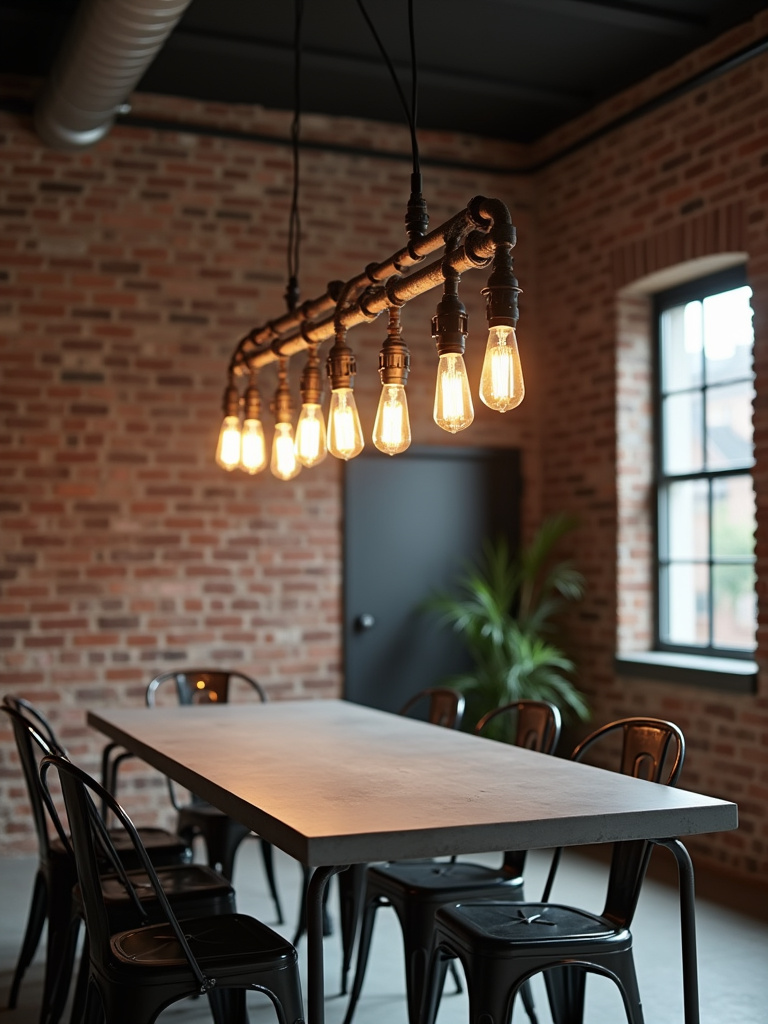
The tricky part is understanding what makes truly authentic industrial dining room lights. The best examples feature exposed bulbs, metal cages, pipes, gears, and unfinished materials like iron and steel. The emphasis is on function first, with a rugged beauty that comes from revealing rather than concealing the fixture’s construction and mechanics.
What’s surprising is how versatile industrial lighting can be. While perfect for loft apartments and urban conversions, these fixtures can also add compelling contrast to softer, more traditional dining spaces. The key is balance – industrial fixtures can provide an edgy counterpoint to traditional elements, creating dining rooms with depth and visual interest.
Consider these industrial lighting approaches:
The industrial design movement emerged organically from the repurposing of old factories and warehouses into living spaces, embracing the raw, functional aesthetic of these structures rather than hiding it. This authenticity gives industrial fixtures a compelling story and visual weight that more decorative styles sometimes lack.
When incorporating industrial lighting, balance the hard, edgy elements with softer textures in the dining room. Wood, fabric, and textiles can prevent the space from feeling too cold or harsh. And consider using dimmer switches with industrial fixtures, especially those with exposed bulbs, to control glare and create a more comfortable dining ambiance despite their utilitarian origins.
If you desire to infuse your dining room with unparalleled glamour and sparkling elegance, crystal chandeliers offer a timeless solution that transcends trends. These fixtures transform ordinary spaces into glittering havens of light and luxury, creating an atmosphere of celebration and refinement.
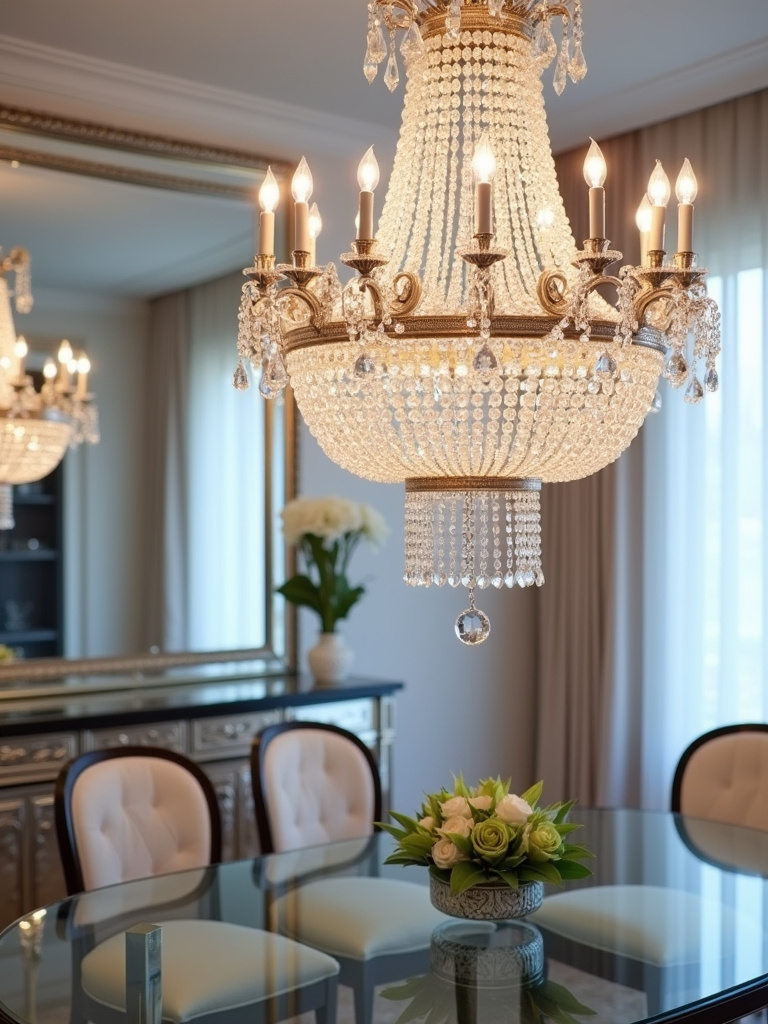
What makes crystal chandeliers truly special is the quality of light they produce. The crystals – whether Swarovski, Strass, or Bohemian – act as prisms, refracting light into countless sparkles that dance across your dining table and walls. This dynamic play of light adds movement and energy to your dining experience, making even ordinary weeknight dinners feel more festive.
This is where things get difficult… selecting the right crystal chandelier requires balancing grandeur with appropriateness for your space. Historically symbols of wealth and luxury found in palaces and grand estates, today’s crystal fixtures can range from elaborate traditional designs to surprisingly sleek contemporary interpretations that work in modern settings.
For modern dining rooms, choose chandeliers with simpler, more streamlined silhouettes and fewer ornate details. Pairing a crystal chandelier with modern furniture and a neutral color palette creates a sophisticated juxtaposition that feels fresh rather than stuffy.
“The sparkle of a crystal chandelier is created by the precise cuts of the crystals, which refract and disperse light in a dazzling display that brings energy and movement to your dining room.”
For maximum impact in a formal dining room, consider a crystal chandelier with a waterfall or cascading design. The vertical arrangement creates a breathtaking focal point and maximizes light reflection. In more contemporary settings, a drum-shaped crystal chandelier with a minimalist metal frame offers subtle glamour without overwhelming the space.
Do you see how huge that is? Crystal chandeliers don’t just illuminate your dining table—they transform the entire atmosphere of the room, creating a sense of occasion that elevates everyday dining to something special. When cleaning these magnificent fixtures, use a soft, lint-free cloth and specialized crystal cleaner, handling each piece carefully to preserve its brilliance. And always ensure your ceiling junction box is rated to support the weight, as crystal chandeliers can be quite substantial.
For dining rooms that value contemporary style alongside lasting quality, modern metal pendant lights offer an ideal combination of sleek aesthetics and enduring durability. These fixtures bring clean lines, refined materials, and versatile design that complements various modern dining environments.
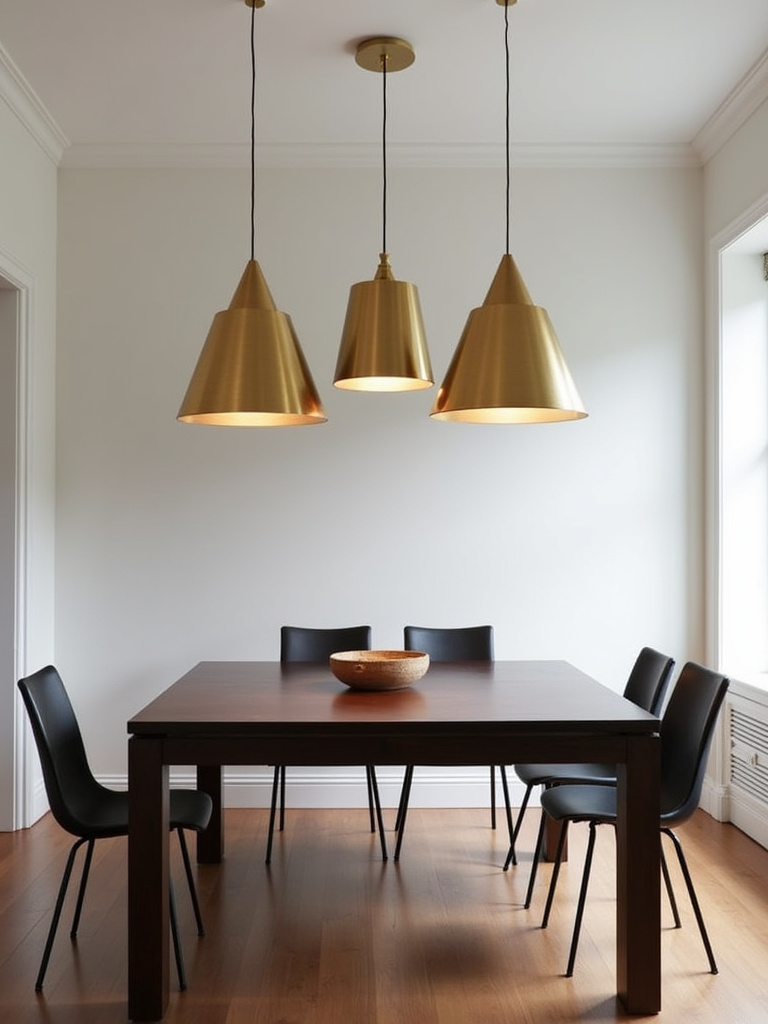
The driving force behind the popularity of metal pendants is their remarkable versatility. Metals like brushed nickel, polished chrome, stainless steel, brass, copper, and matte black each bring their own distinctive character to a dining space while offering exceptional durability and longevity.
The finish you select can dramatically influence your dining room’s atmosphere. Polished metals like chrome and brass reflect more light, creating a brighter, more energetic dining experience. Brushed or matte metals offer a softer, more diffused light and understated elegance. Warm metals like brass and copper add richness and depth that feels especially inviting in dining areas.
For a trending look that balances contemporary and timeless elements, try hanging a cluster of brass pendant lights with geometric metal shades over your dining table. The warm metallic finish adds sophistication while the clean geometric forms maintain modern sensibilities. Alternatively, sleek stainless steel pendants with minimalist glass shades create a crisp, contemporary dining space that feels fresh and uncluttered.
The versatility of metal allows for a wide range of designs in modern pendant lighting, from simple geometric shapes to more intricate and sculptural forms. This adaptability means you can find metal pendants to complement virtually any contemporary dining room style, from minimalist to eclectic.
It works something like this: when selecting metal pendant lights, consider the existing metal finishes in your dining room—cabinet hardware, faucet fixtures, even furniture details—to create a cohesive look. Regular cleaning with a soft cloth will remove dust and fingerprints, maintaining the fixture’s shine and impact. Use appropriate metal cleaners for specific finishes when needed to preserve their beauty.
If you desire to bring a touch of nature and organic warmth into your dining room, lighting fixtures with wood accents provide a beautiful solution. Wood introduces texture, visual interest, and a grounding quality that instantly makes dining spaces feel more inviting and comfortable.
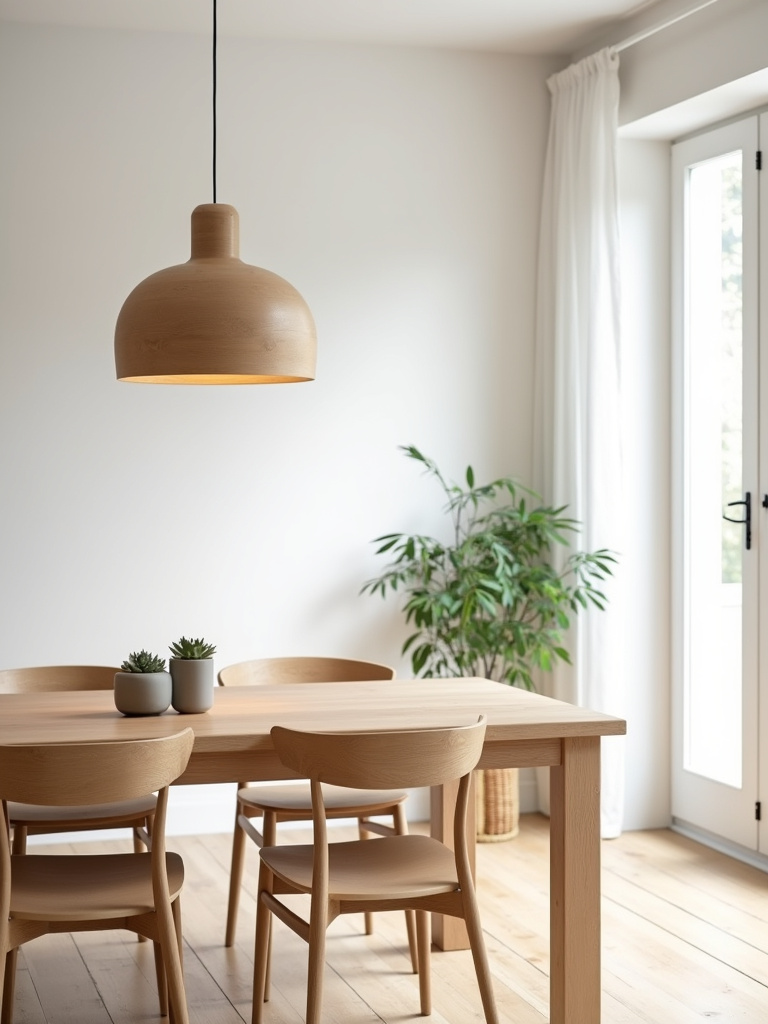
What many people overlook is how different wood types can create distinctly different moods in your dining area. Oak, walnut, maple, birch, bamboo, and reclaimed wood each bring their own color tones, grain patterns, and character to your lighting design. Lighter woods like maple and birch create an airy, Scandinavian feel, while darker woods like walnut add richness and gravitas.
Wood adds natural warmth that contrasts beautifully with cooler materials like metal and glass, creating balance and visual harmony. This juxtaposition of elements—combining the organic with the manufactured—creates depth and interest that makes dining rooms feel thoughtfully designed rather than formulaic.
For an earthy, natural touch, choose pendant lights with wooden shades or frames that allow the wood’s natural grain to be showcased. Another approach integrates architecture with lighting design by incorporating a wooden beam as a structural element from which pendant lights are suspended, creating a rustic-modern aesthetic that feels both timeless and contemporary.
“Wood has been used in lighting design for centuries, from wooden candle holders to elaborate wooden chandeliers. Today’s designs honor this legacy while introducing modern sensibilities.”
I’ll walk you through selecting the right wood lighting for your dining space. Consider the existing wood tones in your furniture and flooring to create a cohesive look—they don’t need to match exactly, but should harmonize within the same color family. Protect wood lighting fixtures from excessive moisture or heat, and dust them regularly to maintain their natural beauty and extend their lifespan.
The breakthrough came when designers began incorporating sustainable wood sources like reclaimed barn wood and fast-growing bamboo into lighting designs. These eco-friendly options offer unique character while addressing environmental concerns, adding another layer of meaning to these beautiful fixtures.
For those who view lighting as both functional necessity and artistic expression, sculptural glass pendants offer a captivating way to elevate your dining room. These fixtures transcend mere illumination, becoming floating works of art that add personality, color, and visual interest to your dining space.

The unexpected twist in sculptural glass lighting comes from the incredible variety of techniques and materials available. Blown glass, hand-blown glass, Murano glass, frosted glass, textured glass, and colored glass each create distinctly different effects in both the fixture itself and the light it casts. Some disperse light evenly throughout the room, while others create fascinating patterns and shadows that add another dimension to your dining experience.
Sculptural glass pendants serve as both lighting and art in your dining room. Their unique shapes, colors, and textures make them focal points even when not illuminated, functioning as decorative art pieces that enhance your room’s aesthetic. When lit, they transform again, taking on new life and character that changes with the intensity of the light.
For maximum impact, hang a single large, hand-blown glass pendant with an organic, asymmetrical shape over your dining table. This creates not just a light source but a conversation piece that expresses your appreciation for artisanal craftsmanship. Alternatively, cluster multiple smaller sculptural glass pendants of varying shapes, heights, and possibly colors to create a dynamic and artistic lighting installation that feels personally curated.
What’s fascinating is that hand-blown glass pendant lights are often crafted individually by artisans, making each piece unique. This one-of-a-kind quality adds to their artistic value and ensures your dining room lighting won’t be duplicated in another home. Colored glass pendants cast beautiful tinted light patterns, adding depth and visual interest beyond what standard fixtures can achieve.
When installing sculptural glass pendants, handle them with care to avoid breakage, especially hand-blown glass which can be delicate. Consider the color palette of your dining room when choosing sculptural glass, selecting colors that either complement or provide a carefully considered contrast to your existing décor. The right glass pendant becomes not just a light fixture, but a signature element that defines your dining space.
In our increasingly connected world, smart dimmable lights bring unprecedented control and versatility to dining room lighting. These intelligent fixtures allow you to adjust brightness, create lighting scenes, and even change colors—all with the tap of a smartphone screen or a simple voice command.
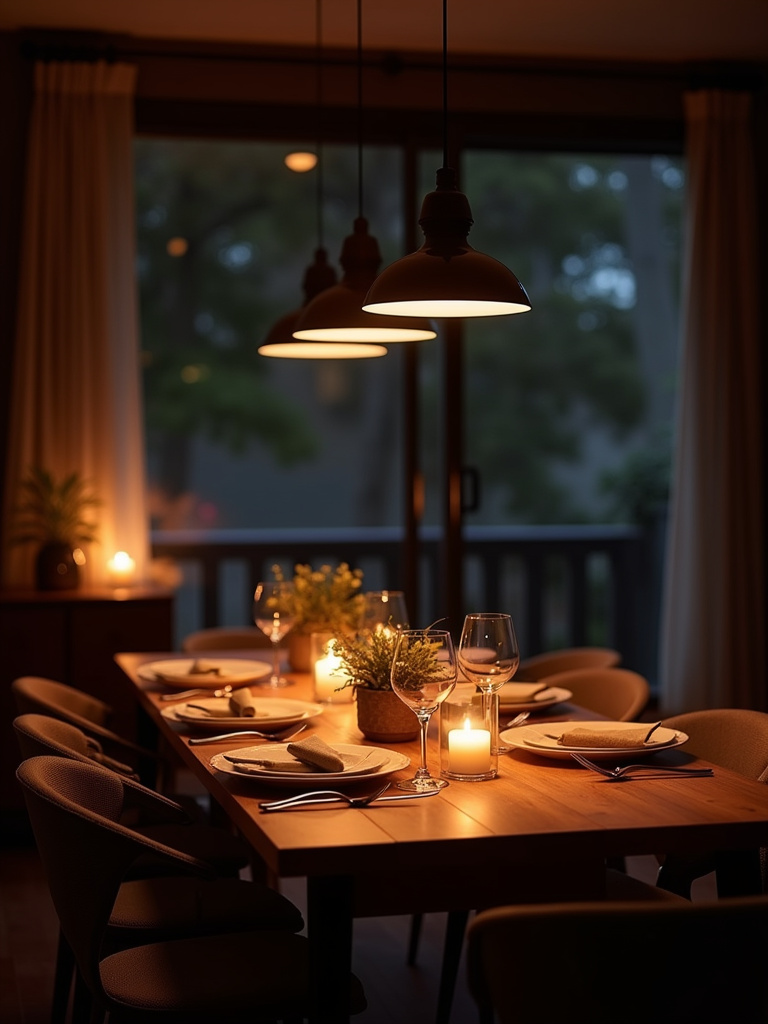
Here’s why that happens: smart lighting technology has evolved to put precise control literally at your fingertips. The benefits for dining rooms are substantial—you can adjust light intensity for different occasions, from bright and energetic for family meals to soft and intimate for romantic dinners. This flexibility allows one lighting fixture to serve multiple purposes, adapting to your needs without requiring multiple different light sources.
Smart lighting systems come in several forms, each with distinct advantages. Smart bulbs offer individual control and often color-changing capabilities, perfect for dining rooms where you want to create different moods. Smart switches and dimmers provide whole-fixture control and scheduling features, ideal for controlling overhead dining fixtures. Popular systems like Philips Hue, Lutron Caseta, and Wemo offer varying features and integration capabilities to suit different preferences.
Consider these smart lighting approaches for your dining room:
The implications are staggering… some smart lighting systems can be programmed to automatically adjust throughout the day, mimicking natural daylight patterns and potentially improving mood and well-being. Others offer color-changing capabilities, allowing you to set themed lighting for special occasions or holidays without changing your physical décor.
When choosing a smart lighting system for your dining room, ensure compatibility with your existing smart home ecosystem if you have one. Check manufacturer guidelines to confirm that bulbs, dimmers, and switches work together properly. The initial setup may take a bit more effort than traditional lighting, but the flexibility and convenience make it worthwhile for many homeowners seeking next-level dining ambiance.
For dining rooms with rectangular tables, linear suspension lights offer a perfectly proportioned lighting solution that enhances both form and function. These elongated fixtures mirror the shape of the table beneath them, creating a harmonious visual balance while providing even illumination across the entire dining surface.
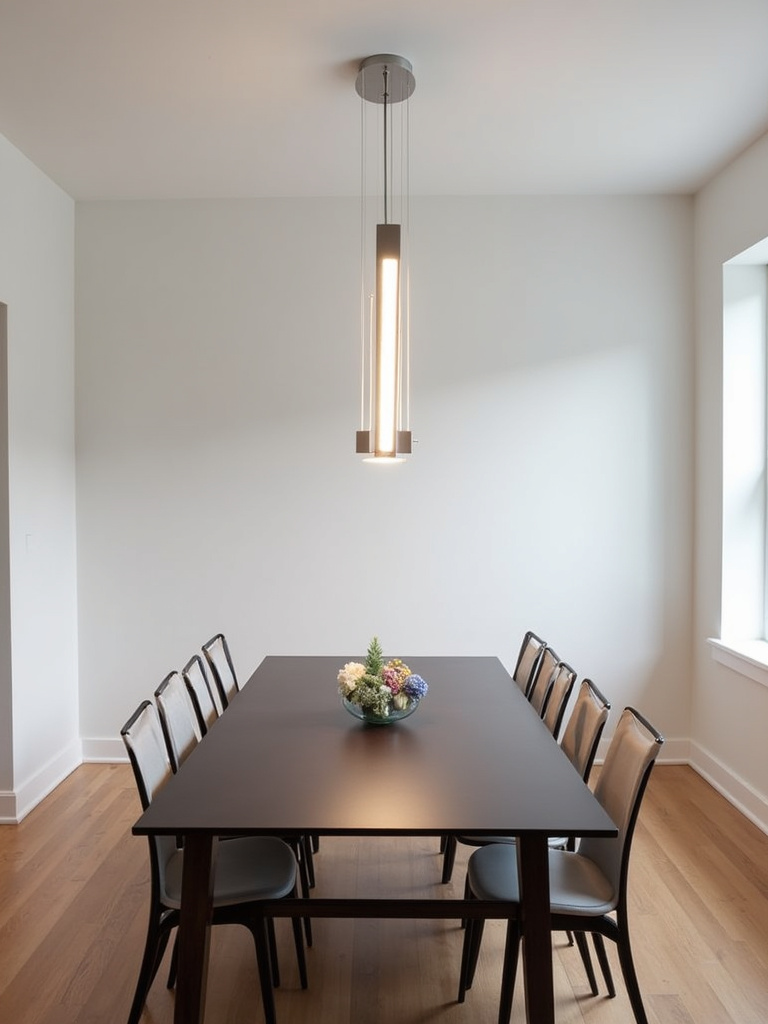
The key factor here is balance and proportion. Linear suspension lights provide consistent illumination along the length of a rectangular dining table, ensuring every seat receives equal light. Their elongated shape also visually complements the table’s form, creating a sense of symmetry and intentionality in your dining space design.
Available in a wide range of styles, linear suspension lights can suit virtually any design preference. Options range from minimalist LED bars with clean lines to more decorative fixtures with multiple glass shades, fabric diffusers, or even integrated crystal elements. Finishes include brushed nickel, matte black, brass, and chrome to coordinate with your existing décor elements.
For a clean, contemporary look, install a long, minimalist linear LED suspension light in matte black over a modern rectangular dining table. This sleek approach emphasizes the architectural aspects of both the fixture and the dining space. For more visual interest, choose a linear suspension with multiple pendant lights suspended from a horizontal bar, creating rhythm and detail while maintaining the overall linear form.
It’s kinda like the dining room equivalent of a perfectly tailored suit—linear suspension lights are specifically designed to complement the proportions of rectangular tables, creating a custom look that feels intentional and considered. Many models offer adjustable hanging heights, allowing you to customize the fixture’s position for optimal lighting and visual impact.
When selecting a linear suspension light, measure your dining table carefully and choose a fixture that is approximately two-thirds to three-quarters the length of the table. This proportion creates visual harmony without overwhelming the space. Ensure the light is centered above the dining table for balanced illumination and clean visual lines that enhance your dining experience.
If you want to make a dramatic statement and create a truly eye-catching focal point above your dining table, cluster pendant lights deliver unmatched visual impact. These dynamic arrangements group multiple pendant lights together, creating an artistic lighting installation that commands attention and defines your dining space.
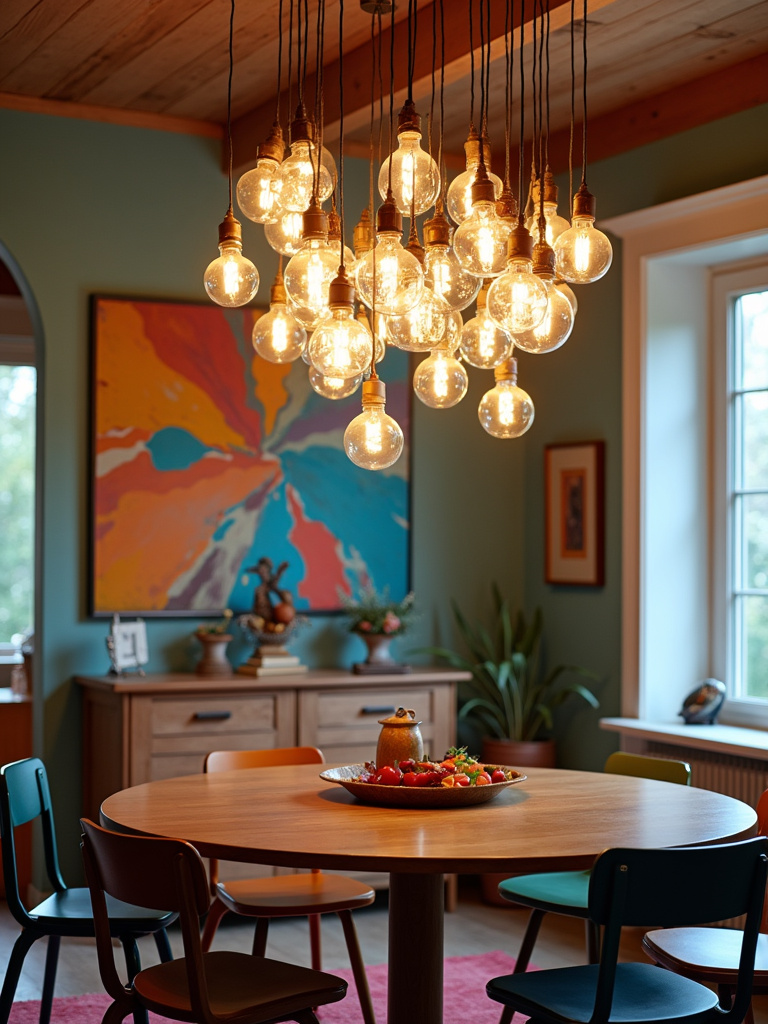
Let me paint you a picture… cluster pendants are essentially compositions of light, where multiple individual pendants come together to create something greater than the sum of their parts. They provide both ambient and task lighting while functioning as sculptural elements that express personality and design sensibility in a way single pendants cannot match.
The beauty of cluster pendants lies in their endless creative possibilities. Arrangements can be symmetrical for a more formal look, asymmetrical for artistic flair, cascading to create vertical drama, or geometric to emphasize pattern and repetition. Pendants can be suspended at varying heights, in different shapes, or with mixed materials to create unique visual effects that reflect your personal aesthetic.
Consider these inspired approaches:
What makes cluster pendant lights particularly effective is their ability to define and anchor the dining area while adding personality. The individual pendants in a well-designed cluster can often be adjusted independently, allowing for customizable lighting direction and spread that can be adapted to different dining scenarios.
Here’s the catch… planning a successful cluster pendant installation requires careful consideration of scale and proportion. Ensure the overall arrangement is proportional to both your table and the room itself. Too small, and the cluster will appear insignificant; too large, and it may overwhelm the space. Use a pendant light canopy designed specifically for cluster installations to neatly manage the wiring and hanging points for multiple pendants.
The possibilities for creative expression with cluster pendants are virtually limitless, offering a way to bring artistic personality to your dining room through the essential element of light. Whether you prefer dramatic and bold or subtle and sophisticated, there’s a cluster pendant configuration that can transform your dining space into something truly unique.
For dining rooms that seek a touch of timeless sophistication and the glamorous elegance of a bygone era, Art Deco lighting offers an enduring solution that never goes out of style. These fixtures embody the geometric precision, luxurious materials, and streamlined forms that defined the iconic design movement of the 1920s and 1930s.
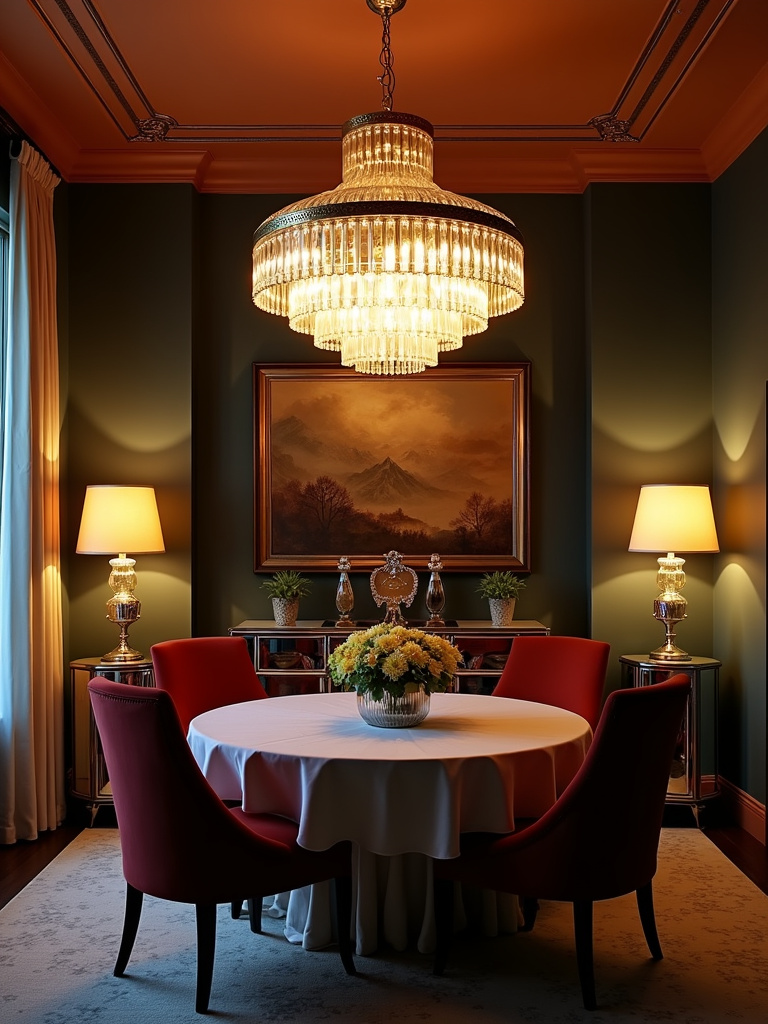
The essence of it all is understanding what makes authentic Art Deco dining room lights so distinctive. The characteristic design elements include strong geometric shapes (zigzags, chevrons, stepped forms), luxurious materials like polished metals (brass, chrome), glass (often frosted or etched), and a commitment to symmetry and clean lines. These elements combine to create fixtures with unmistakable vintage glamour and sophisticated energy.
While rooted in historical design, Art Deco lighting harmonizes surprisingly well with contemporary interiors. The key to incorporating these vintage-inspired fixtures into modern dining rooms lies in balance—choose pieces with clean lines and classic Art Deco motifs, then pair them with contemporary furniture and a sophisticated color palette. This creates a dialogue between past and present that feels fresh rather than antiquated.
For maximum impact, install an Art Deco chandelier with geometric glass panels and polished brass accents as your dining room centerpiece. The structured elegance of such a fixture adds instant character and historical connection. For more subtle Art Deco touches, use wall sconces with stepped metal details and frosted glass shades to flank a mirror or artwork, adding architectural interest without overwhelming the space.
“Art Deco emerged as a celebration of modernity, technology, and luxury—qualities that still resonate in contemporary design. Its emphasis on geometric clarity shares surprising connections with Islamic design traditions, both valuing pattern, proportion, and mathematical harmony.”
When selecting Art Deco lighting, consider scale and proportion relative to your dining space. Larger chandeliers create drama in formal dining rooms, while smaller sconces and pendants bring Art Deco elegance to more intimate settings. For a cohesive look, pair your lighting with other Art Deco-inspired elements—geometric patterns, metallic accents, and rich fabrics—to create a dining room with vintage glamour and sophisticated style.
The mirrored surfaces and metallic finishes often used in Art Deco lighting enhance its glamorous impact by reflecting light throughout the space, creating a luminous atmosphere perfect for entertaining. This interplay of light and reflection was integral to the original Art Deco aesthetic and remains equally effective in contemporary dining rooms seeking to capture that same sophisticated ambiance.
Light shapes our experiences in profound ways, especially in spaces dedicated to gathering, nourishment, and connection. The dining room light you choose does more than merely illuminate your table—it establishes mood, enhances your décor, and transforms ordinary meals into memorable experiences.
Throughout Islamic design history, light has been treated as a transformative element—filtering through intricate screens, dancing across geometric patterns, and creating atmospheres of both tranquility and celebration. This ancient wisdom about light’s power to transform space remains equally relevant in our contemporary homes.
As you consider the perfect dining room light for your space, remember that the best choice balances:
Whether you’re drawn to the glamorous sparkle of crystal, the warm honesty of farmhouse pendants, the sleek precision of modern fixtures, or the playful personality of cluster arrangements, the perfect dining room light awaits. Each option we’ve explored offers its own unique character and benefits, ready to transform your dining space into something extraordinary.
The dining table is where we gather not just for sustenance, but for connection—where conversations flow, celebrations unfold, and memories are crafted. The light that shines upon this space deserves thoughtful consideration, as it silently shapes these precious moments and elevates everyday experiences into something beautiful.
Let your dining room light be a reflection of your personal style, cultural appreciation, and commitment to creating a space where beauty and function harmonize perfectly. After all, in both design and dining, it’s the thoughtful details that transform the ordinary into the exceptional.